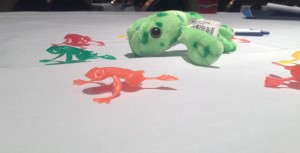Colorful toy frogs lay as centerpieces atop the white-table covers at the Nittany Lion Inn’s main banquet hall, where the Penn State Network on Child Protection and Well-Being recently held its fourth annual conference.
 “We’re going to make leaps across the stepping stones of the scientific process,” Network Director Jennie Noll said.
“We’re going to make leaps across the stepping stones of the scientific process,” Network Director Jennie Noll said.
Throughout the four sessions a few presentations stood out to me:
Idan Shalev presented an interesting talk in the genomics session. He studies telomeres, which are the protective segments of DNA structures at the end of linear chromosomes. He compared them to the tips of the end of a shoelace. Shalev found that telomeres get shorter as a result of life stress and that there is a decreased life expectancy for people with shorter telomeres than for people with longer telomeres.
When graphs from his studies popped on the three screens, eyebrows furrowed and foreheads scrunched in concentration. The session about genomics was the most intricate and complicated topic of the conference, in my opinion.
Bruce Ellis’s presentation specifically struck me because it urged me to think about solutions for child-maltreatment victims in a different way. His session focused on the endocrinology and immunology of child maltreatment and stress.
Ellis said there is a “mismatched assumption” that these victims are broken and need to be fixed. On the contrary, traumatic events strengthen certain adaptation mechanisms that scientists should be working with, not against.
For example, physically abused children are highly attuned to threat-related information such as identifying an angry face. Resilience interventions that try to alter these children to act, think and behave like children who have not had this traumatic experience don’t consider the beneficial adaptations children gain from these types of experiences.
In some ways it felt like the conference was a big classroom. As Ellis spoke, accomplished speakers and researchers sat alongside Penn State undergraduate students jotting down notes.
I took a particular interest in Steve Suomi’s presentation on resilience where he explained his work on the early development in rhesus monkeys. He provided live footage of his findings, which was intriguing because of the comparable effects between humans and monkeys.
“I want to tell you a story about a sixth-grader named Sammy” Victor Carrion said during his presentation on brain development.
His story showed firsthand what PTSD does to a child and helped me to better understand what happens in a child’s mind after a traumatic event. The story solidified the importance of Carrion’s intervention efforts in which he helps kids identify the cues and triggers that awaken their PTSD behaviors.
Carrion exemplified an important part of translational science during the intervention portion of his presentation. He translates his findings to victims so they can better understand what happens to their minds and bodies in reaction to their PTSD disorder. He helps victims understand how their trauma has impacted them on four core domains: cognition, behavior, emotion and physiology.
I felt a bit out of place with my background in journalism as I sat among some of the world’s most esteemed scientific researchers. Even their jokes were above my head. But as the conference progressed my “outsider” feeling began to fade.
The open discussion at the end of the conference eliminated whatever was left this feeling as the researchers discussed the importance of communication.
Scientists sometimes struggle to explain their important findings in ways that are presentable to the general public and in ways that attract the general public. And here I am doing just that for an audience of those researchers and people with a level of understanding similar to mine.
The scientists at the conference do what they do for the same reason I am writing this blog. It’s the same reason why, I hope, you’re reading this blog.
All the researchers, practitioners, professors and students who sat in that banquet hall want to help the victims of child maltreatment and childhood adversity. We want to move this research forward and, as Noll said, “make leaps” toward future research and solutions.

